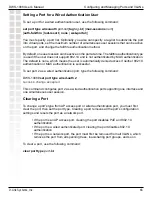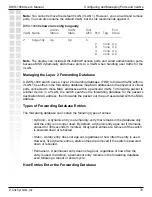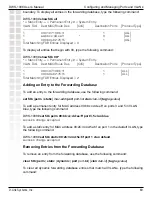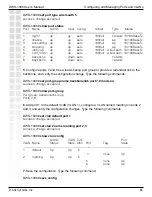
79
DWS-1008 User’s Manual
D-Link Systems, Inc.
Configuring and Managing Ports and VLANs
An entry enters the forwarding database in one of the following ways:
• Learned from traffic received by the switch - When the switch receives a packet,
the switch adds the packet’s source MAC address to the forwarding database if the
database does not already contain an entry for that MAC address.
• Added by the system administrator - You can add static and permanent unicast
entries to the forwarding database. (You cannot add a multicast or broadcast
address as a permanent or static forwarding database entry.)
• Added by the DWS-1008 switch itself - For example, the authentication protocols
can add entries for wired and wireless authentication users. The switch also adds
any static entries added by the system administrator and saved in the configuration
file.
Displaying Forwarding Database Information
You can display the forwarding database size and the entries contained in the database.
Displaying the Size of the Forwarding Database
To display the number of entries contained in the forwarding database, use the following
command:
show fdb count
{
perm
|
static
|
dynamic
} [
vlan
vlan-id
]
For example, to display the number of dynamic entries that the forwarding database contains,
type the following command:
DWS-1008#
show fdb count dynamic
Total Matching Entries = 2
Displaying Forwarding Database Entries
To display the entries in the forwarding database, use either of the following commands:
show fdb
[
mac-addr-glob
[
vlan
vlan-id
]]
show fdb
{
perm
|
static
|
dynamic
|
system
|
all
} [
port
port-list
|
vlan
vlan-id
]
The
mac-addr-glob
parameter can be an individual address, or a portion of an address
with the asterisk (*) wildcard character representing from 1 to 5 bytes. The wildcard allows
the parameter to indicate a list of MAC addresses that match all the characters except the
asterisk.
Use a colon between each byte in the address (for example,
11:22:33:aa:bb:cc
or
11:22:33:*
).
You can enter the asterisk (*) at the beginning or end of the address as a wildcard, on any byte
















































